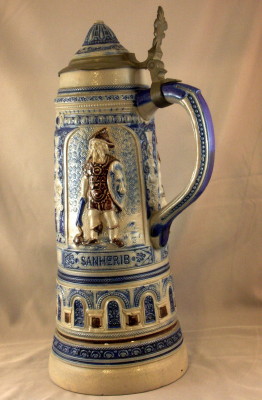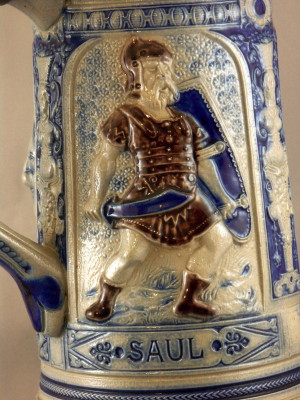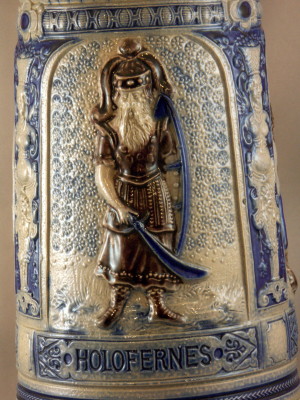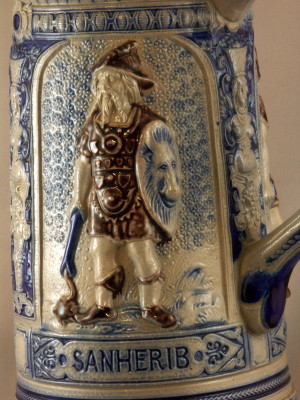| Featured Stein: January 2009 |
| ~
Biblical Pride Stein ~
by Stewart Eastman |
Previous
Archives Home |
 |
The stein was described by the seller, a Christian bookstore, as depicting “Kings of Israel”; but, the seller was evidently not well versed in either steins or the Bible. In three arch-enclosed panels stand men dressed in armor similar to ancient Roman soldiers. Their names are written beneath each: Saul, Holofernes, and Sanherib. Saul was indeed a King of Israel, the first in fact; but, the others were not. Holofernes is not often depicted as a strong, standing soldier. Usually one just sees his head, carried by Judith or her maidservant. Holofernes was the general sent by the King of Babylon to attack Israel who, while besieging, was seduced by the beautiful Jewish widow Judith. She then cut his head off and hung it from the city walls. This dismayed the Babylonian troops, and they were defeated. Sanherib is the German spelling of Sennacherib. He was an Assyrian king, and among his exploits was a siege of Jerusalem that, according to the Bible, failed when God slew a large proportion of his army.
The Assyrians recorded another story; but, either way he met a sad end slain by his own sons. King Saul, for that matter, was first King of Israel, but not the best. He eventually committed suicide after a military defeat. So, what are these fellows doing on this beer stein? Why are they together at all?
Fortunately these are rather uncommon names, and it was not hard to trace that they were brought together by Dante in his Divine Comedy. They are found in Purgatory, on the Terrace of Pride, as carvings illustrating infamous examples of that sin. Still, that's not particularly German, and the scene is not illustrated. Although Dante had not been translated into German yet, a couple of hundred years later the greatest of the meistersingers, Hans Sachs, had evidently heard a similar story. He composed two poems or songs entitled “The Gate of Honor” and the “The Gate of Shame”. Naturally the stein's three warriors are found in “The Gate of Shame”.
 |
 |
 |
| King Saul | Holofernes | Sanherib |
|
So far so good; but, still, why are these sinners on a beer stein, rather than some more convivial scene?
It was popular in the late 19th century to copy the designs of late Renaissance steins from the 16th and 17th
centuries. In those times, in turn, it was popular to decorate steins with copies of woodcuts with
biblical themes. When Sachs' poem was published, it was accompanied by woodcuts of the characters mentioned
done by the artist Peter Floetner. The surviving woodcuts do not appear to be quite the same as those on
this stein, but Floetner's work is in the same style. Floetner created sculptures, designed medals, and
even a set of playing cards. The Jack of Hearts, in his set, holds a beer stein of the old, jug-like fashion.
My conclusion is that Floetner's woodcuts for the poem, or a similar set of illustrations for it, were used to decorate a stein of his period. This in turn was used as a model, perhaps by Gerz, in the late 19th century. As for the moral of the story, perhaps I should not become too proud of my stein collection else I may come to a bad end. |
|
All rights reserved. |